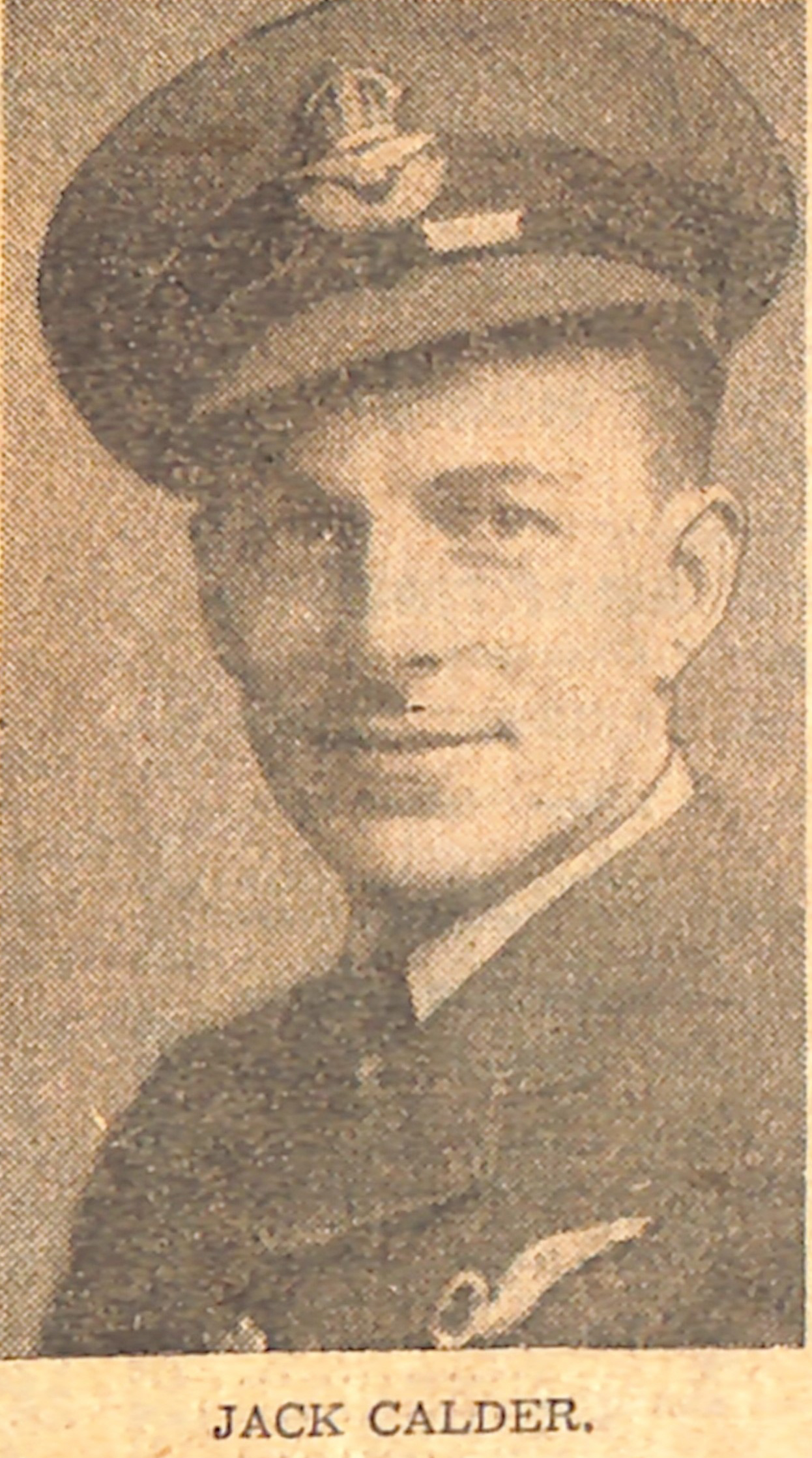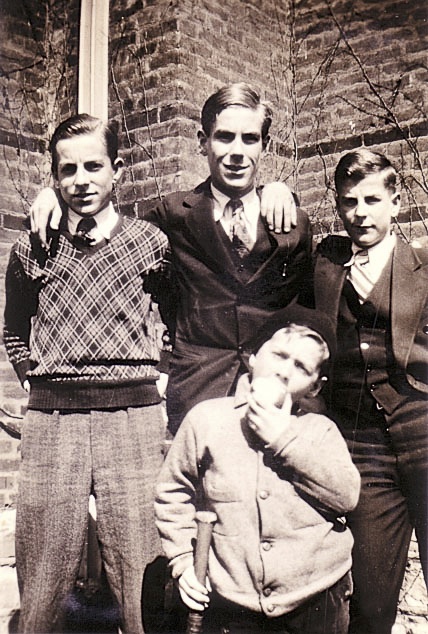About Jack Calder

Finding Two Jack Calders
By Patricia Calder and Heidi LM Jacobs
In compiling Jack Calder at War: A Canadian Mother’s WWII Scrapbook, we noticed that there are two Jack Calders. The first is the public Jack Calder, the journalist from Chatham, Ontario known for his local, regional, and national sports coverage and later his nationally published coverage of his experiences as a navigator in World War II. The second man is Jack, the son of Agnes and Archie Calder and uncle of Patricia Calder. Both Jack Calders are to be found in the pages of Agnes Calder’s scrapbook. Calder the journalist can be found in the newspaper coverage both about and by him that she clipped out and saved in her scrapbook. But also, and perhaps most poignantly, Agnes Calder’s scrapbook preserves Jack: the man, the son, the brother, the boyfriend, the uncle.
John Philip Sargent Calder, or Jack as he was called, was born February 4, 1915. The second son of Archibald Clement Calder and Mary Agnes Harding Calder, Jack was born in Regina while his father was a rector in Qu’Appelle, Saskatchewan. The family moved to Southwestern Ontario where Archie Calder was rector in Wallaceburg and later at Chatham’s Holy Trinity Church. Archie was Kent West’s Conservative member of the Ontario Legislature from 1926 to 1934. Jack Calder attended Chatham Collegiate Institute, where he wrote for the school newspaper. It is unclear when Calder began writing as a sports columnist for the Chatham Daily News, but in 1933, when he was only eighteen, he contributed to “Casual Comment on Current Sport,” a regular column that brought together small news items and commentaries about local, regional, and, to a lesser extent, professional sports.

In 1934, Calder got his own column “Analyzing Sport,” where he most notably documented the barrier-breaking season of the 1934 Chatham Coloured All Stars. Calder continued writing for the Chatham Daily News sports pages throughout 1935. In October 1936, a wire story from Sarnia stated that Calder “announced he was leaving for England next week with a view to writing hockey news for English papers.” In the spring of 1937, a story by Calder covering hockey in Toronto was printed and his name appeared in national and regional newspapers as a Canadian Press Staff Writer.
While he continued to write about sports, the focus of his writing shifted after he joins the Royal Canadian Air Force in May, 1940. While serving in the military, he wrote for the Canadian Press and published articles in the Toronto Star, Globe and Mail, and Maclean’s magazine, about the war and his various adventures, including his first plane crash and his time as a prisoner of war in Eire, (now the Republic of Ireland). Calder smuggled a news story out of the camp through his brother and it was published in Maclean's. He later escaped from the camp. Jack Calder was killed in action in July 1944, at the age of twenty-nine, after his third plane crash.
Upon his death, a wire story observed, “Colleagues remember him as a tall, quiet redhead with an acute sense of personal responsibility. Sports editors across Canada knew his byline meant a studied story with a touch of class. When Jack Calder left a [Canadian Press] desk to join the R.C.A.F. in 1940, fellow workers were sorry to see him go.” A Jack Calder Memorial Cup softball game was planned in Chatham, where funds were raised to purchase a plaque to be placed in the school he attended. The Western Ontario Sports Writers Association created a Jack Calder Trophy to be given as an annual award to the outstanding high school boy athlete in Western Ontario.[1]
But journalist Jack Calder was also Jack—son to Agnes and Archibald, brother to Jake, Gerald, Mary, Marjorie, and Philip, sweetheart of Ann, and, later, uncle to numerous nieces and nephews, including Patricia.
Patricia Calder’s famous uncle, Jack was a navigator flying heavy bombers like the Wellington and later Mosquitos during World War II. Because he had been an editor with Canadian Press in Toronto and Montreal before the war, he continued to write and publish from the front.[2]
He was the first to report about meeting the Royal family while visiting the gardens of Windsor Castle, and being invited to tea, answering questions from the King and Queen, and Princesses Elizabeth and Margaret Rose.
He was the first to write about a raid from inside a bomber, how they shot down three enemy aircraft, and shot up the docks of Brest, although they missed their target, the German pocket-battleship, Gneisenau.
He was the first to publish an article in Maclean’s magazine after his plane crashed in Eire (Republic of Ireland) and he and the crew were taken prisoner. Then followed a twenty-month internment in the Curragh prison, famous in IRA days; in fact, many of the guards were former IRA members. Even though Jack and his men attempted to escape eleven times, the guards ‘knew all the tricks.’
Eventually however, he did escape, under a cloak of secrecy. Retraining followed, because navigation tools and aircraft had improved that much in the twenty months that Jack had been absent from action.
However, as luck would have it, he crashed again, this time during a night training flight near Scotland. Luck indeed, for a nurse just happened to be hiking in the mountains. She walked ten miles to the crash site to rescue Jack and get him to the most famous hospital for severe injuries in the UK, the Queen Victoria in East Grinstead. Recovery took eight months and during this time Jack was writing again, about his treatment, and the new hospital wing which was under construction for Canadian airmen.
Finally he achieved his thirty-month goal of rejoining the action. He was promoted to the elite Pathfinder group, flying Mosquitos, marking targets for the bombers which followed in the hundreds by this time. As Ralph Keefer has written, Calder was
“racking up the missions. It was a difficult period with the romance of flight having long given way to the drudgery of the job, with so many empty chairs in the mess each week that they scarcely knew whose turn would be next. It was also rewarding. . . . They had already won the air war. . . . They could have gone home, having each completed several operational tours (30 missions/ea). . . . But they had made a promise. And they were not about to quit while they were ahead.”[3]
Patricia notes that “All the information about Jack I found in my grandmother’s scrapbook. She collected every article published by or about him. As his fame grew, so did the number of newspapers that reprinted his stories, both in Canada and the USA. My grandparents received multiple telegrams from Jack himself, as well as multiple cables and letters from various personnel in the RCAF, every time Jack went missing and was found again. Of course, he fell in love and sent pictures of his sweetheart home. After the war they planned to marry and ‘have lots of babies.’” A third plane crash in July of 1944, however, took Jack’s life. There would be no wedding.
Given that over 42,000 Canadians lost their lives in World War II, the Calders’ story is certainly not unique. What is unique about Jack Calder’s story is how well it is documented and preserved through this scrapbook. By adding Patricia’s fictional imaginings to the digitized pages of Agnes’s scrapbook, we hope to not only preserve and share the story of one young Canadian at war but also convey the sense of the helplessness felt by Canadian families across the country as they waited for news of their loved ones and the devastating news that 42,042 of those would, like Jack Calder, not be coming home.
[1] Adapted from 1934: the Chatham Coloured All-Stars’ Barrier-Breaking Year by Heidi LM Jacobs (Biblioasis, 2023).
[2] Sometime between Apr. 26 and Jun. 28, 1940 a story was printed with Jack's byline in Chatham Daily News: "Britishers Praised by Canadian Airman." This is the first one he wrote, although he is quoted in earlier stories written by Pat Usher and E.D. Burritt, Canadian Press Staff Writers. Jack's big story was 'Bombing the Gneisenau" published in New York Telegram, Aug. 31, 1941. It was picked up by dailies across US and Canada and later labeled a classic.
[3] See Ralph Keefer’s Grounded in Eire, McGill-Queen’s University Press (2001).
